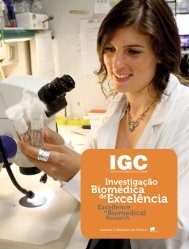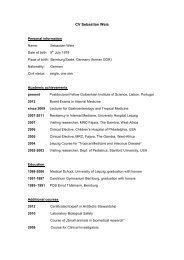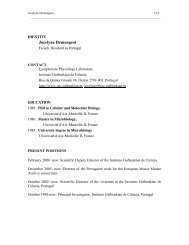organisation - the Instituto Gulbenkian de Ciência
organisation - the Instituto Gulbenkian de Ciência
organisation - the Instituto Gulbenkian de Ciência
- No tags were found...
Create successful ePaper yourself
Turn your PDF publications into a flip-book with our unique Google optimized e-Paper software.
PLANT<br />
GENOMICS<br />
Jörg Becker Research Fellow<br />
PhD in Biology, University of Bielefeld, Germany, 2001<br />
Post-doc, IGC, Portugal<br />
Head of IGC Gene Expression Unit<br />
Research Fellow at <strong>the</strong> IGC since 2008<br />
Our group is interested in <strong>the</strong> mechanisms un<strong>de</strong>rlying sexual reproduction and<br />
early embryogenesis with a particular focus on <strong>the</strong> role of <strong>the</strong> male gametes.<br />
Recent studies have shown that male gametes both in <strong>the</strong> plant and animal<br />
kingdom carry complex sets of RNA molecules, including not only mRNAs but<br />
also small RNAs. We are particularly interested in <strong>the</strong> role of <strong>the</strong>se two RNA<br />
classes before, during and after double fertilisation as it occurs in higher plants.<br />
Using Arabidopsis thaliana as our primary experimental mo<strong>de</strong>l we are addressing<br />
specific questions like:<br />
1. What are <strong>the</strong> functions of small RNA and DNA methylation pathways in<br />
sperm cells?<br />
2. Do sperm cell-<strong>de</strong>rived RNAs play a role after fertilisation?<br />
3. Do conserved core sets of genetic modules un<strong>de</strong>rlie common characteristics<br />
of male gametes across kingdoms?<br />
In addition we are interested in i<strong>de</strong>ntifying gamete-expressed proteins with<br />
functions in signalling events assuring double fertilisation and initiation of embryogenesis.<br />
GROUP MEMBERS<br />
Leonor Boavida (Post-doc)<br />
Filipe Borges (External PhD stu<strong>de</strong>nt)<br />
Patrícia Pereira (External PhD stu<strong>de</strong>nt)<br />
Marcela Coronado (External PhD stu<strong>de</strong>nt, started in February)<br />
Francisco Sousa (Trainee, started in June)<br />
COLLABORATORS<br />
Rob Martienssen (Cold Spring Harbor Laboratory, USA)<br />
Keith Slotkin (Ohio State University, USA)<br />
Ignacio Rubio Somoza (Max Planck Institute for Developmental Biology,<br />
Germany)<br />
Rui Gardner (IGC, Portugal)<br />
José Feijó (IGC, Portugal)<br />
Ji He (The Samuel Roberts Noble Foundation, USA)<br />
Carlos Plancha (Cemeare Lda, Portugal)<br />
Sheila McCormick (US Department of Agriculture/Agricultural Research<br />
Service, USA)<br />
Liam Dolan (Department of Plant Sciences; University of Oxford, England)<br />
FUNDING<br />
Fundação para a Ciência e a Tecnologia (FCT), Portugal<br />
FP7 Marie Curie International Reintegration Grant, European Commission<br />
FP7 Marie Curie Action: "Networks for Initial Training", European Commission<br />
THE ROLE OF SPERM DERIVED microRNAs DURING DOUBLE FERTILISATION<br />
IN ARABIDOPSIS<br />
The world’s current food supplies rely almost exclusively on double fertilisation<br />
as found in higher plants and characterised by <strong>the</strong> fusion of two male gametes<br />
(sperm cells) with two female gametes (egg cell and central cell), giving rise<br />
to <strong>the</strong> embryo and <strong>the</strong> endosperm. Thus a better molecular un<strong>de</strong>rstanding of<br />
double fertilisation will eventually provi<strong>de</strong> <strong>the</strong> tools to improve crops. Micro-<br />
RNAs (MiRs), as essential regulators in <strong>de</strong>velopment processes and hormone<br />
responses, are likely to play a role in sexual reproduction. Our <strong>de</strong>ep sequencing<br />
data of small RNAs from Arabidopsis sperm cells and pollen indicate that <strong>the</strong>se<br />
express MiRs belonging to dozens of microRNA families, with a number of <strong>the</strong>m<br />
showing higher expression levels in sperm cells than in pollen. We are analysing<br />
<strong>the</strong> role <strong>the</strong>se sperm cell MiRs might play for sperm cell viability and, if being<br />
<strong>de</strong>livered to <strong>the</strong> female gametes upon fertilisation, for <strong>the</strong> regulation of early<br />
embryogenesis and endosperm <strong>de</strong>velopment.<br />
We continued to address <strong>the</strong> potential role of MiRNAs in sperm cells using target<br />
mimics and global inhibitors of small RNA pathways. Moreover, using a novel<br />
FACS protocol (manuscript in prep), we isolated Arabidopsis microspores as well<br />
as vegetative nuclei and sperm cells from mature pollen. By <strong>de</strong>ep sequencing<br />
of bisulphite converted genomic DNA from <strong>the</strong>se three sample types we gained<br />
important new insights into epigenetic changes occurring during microgametogenesis<br />
(manuscript in prep).<br />
IDENTIFICATION OF CONSERVED GERM CELL SPECIFIC MODULES<br />
AS POTENTIAL PRECURSORS OF TOTIPOTENCY<br />
Germ cell differentiation gave rise to all sexually reproducing organisms, but<br />
along <strong>the</strong>ir evolution, several species <strong>de</strong>veloped distinct spatial and temporal<br />
control over germline proliferation. The gametes are <strong>the</strong> end products of <strong>the</strong><br />
germ cell lineage, and transfer ultimately to <strong>the</strong> zygote <strong>the</strong>ir unique totipotent<br />
potential, capable of giving rise to an entirely new organism. Despite <strong>the</strong> variety<br />
of mechanisms distinguishing germ cell differentiation and fertilisation strategies<br />
in plants and animals, <strong>the</strong> molecular pathways towards totipotency are<br />
likely to remain conserved in form of a core set of genetic modules un<strong>de</strong>rlying<br />
<strong>the</strong> totipotent potential of <strong>the</strong> gametes. This project focuses on <strong>the</strong> i<strong>de</strong>ntification<br />
of this conserved core set through <strong>the</strong> functional analysis of transcripts<br />
encoding orthologue gene products in male gametes of plant, human and fly.<br />
TRANSGENIC ARABIDOPSIS EXPRESSING GAMETE-SPECIFIC TETRASPANINS.<br />
Upper panel - GFP localisation in <strong>the</strong> plasma membrane of sperm cells (sperm<br />
nuclei mRFP). Bottom panel - Detail of GFP localisation in plasma membrane of<br />
female gametophytic cells: egg cell (right) and synergid cells (left).<br />
IGC ANNUAL REPORT ‘11<br />
RESEARCH FELLOWS<br />
71






